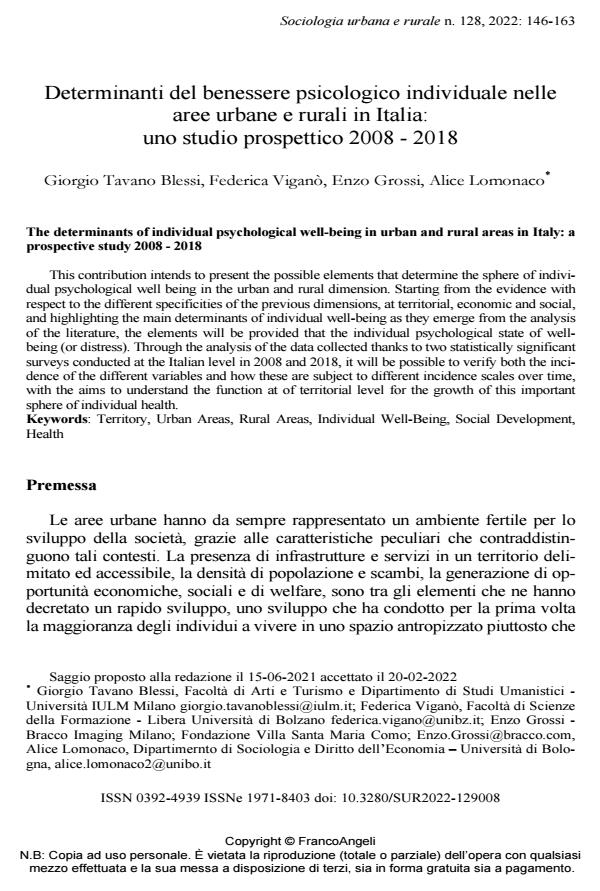Determinanti del benessere psicologico individuale nelle aree urbane e rurali in Italia: uno studio prospettico 2008 - 2018
Titolo Rivista SOCIOLOGIA URBANA E RURALE
Autori/Curatori Giorgio Tavano Blessi, Federica Viganò, Enzo Grossi, Alice Lomonaco
Anno di pubblicazione 2022 Fascicolo 2022/129
Lingua Italiano Numero pagine 18 P. 146-163 Dimensione file 319 KB
DOI 10.3280/SUR2022-129008
Il DOI è il codice a barre della proprietà intellettuale: per saperne di più
clicca qui
Qui sotto puoi vedere in anteprima la prima pagina di questo articolo.
Se questo articolo ti interessa, lo puoi acquistare (e scaricare in formato pdf) seguendo le facili indicazioni per acquistare il download credit. Acquista Download Credits per scaricare questo Articolo in formato PDF

FrancoAngeli è membro della Publishers International Linking Association, Inc (PILA)associazione indipendente e non profit per facilitare (attraverso i servizi tecnologici implementati da CrossRef.org) l’accesso degli studiosi ai contenuti digitali nelle pubblicazioni professionali e scientifiche
This contribution intends to present the possible elements that determine the sphere of individual psychological well being in the urban and rural dimension. Starting from the evidence with respect to the different specificities of the previous dimensions, at territorial, economic and social, and highlighting the main determinants of individual well-being as they emerge from the analysis of the literature, the elements will be provided that the individual psychological state of wellbeing (or distress). Through the analysis of the data collected thanks to two statistically significant surveys conducted at the Italian level in 2008 and 2018, it will be pos-sible to verify both the incidence of the different variables and how these are subject to different incidence scales over time, with the aims to understand the function at of territorial level for the growth of this important sphere of individual health.
Parole chiave:Territory, Urban Areas, Rural Areas, Individual Well-Being, Social Development, Health
- Il ruolo della cultura nella costruzione del benessere. Evidenze a livello nazionale 2008-2018 Giorgio Tavano Blessi, Federica Viganò, Enzo Grossi, in SOCIOLOGIA URBANA E RURALE 130/2023 pp.111
DOI: 10.3280/SUR2023-130007
Giorgio Tavano Blessi, Federica Viganò, Enzo Grossi, Alice Lomonaco, Determinanti del benessere psicologico individuale nelle aree urbane e rurali in Italia: uno studio prospettico 2008 - 2018 in "SOCIOLOGIA URBANA E RURALE" 129/2022, pp 146-163, DOI: 10.3280/SUR2022-129008